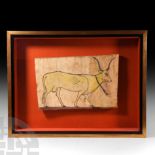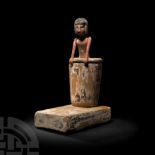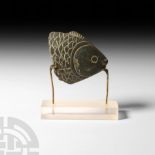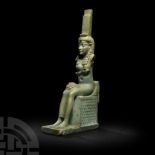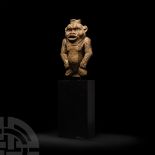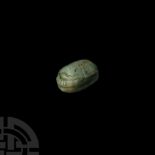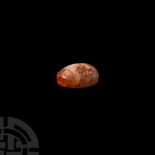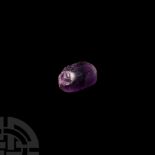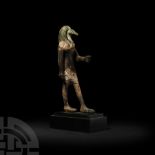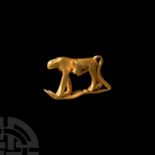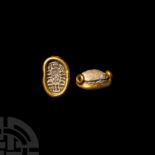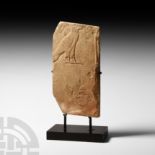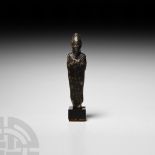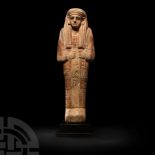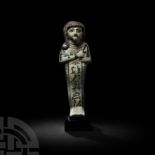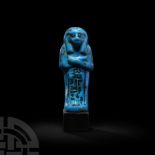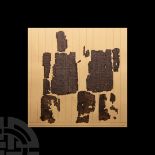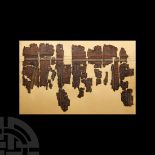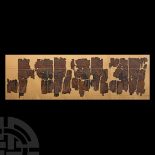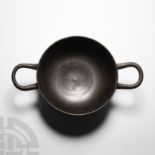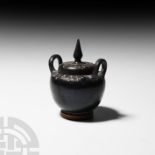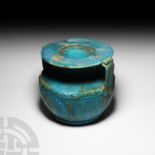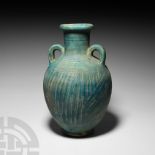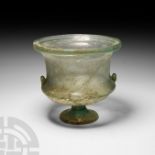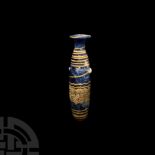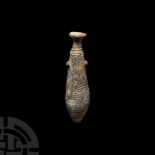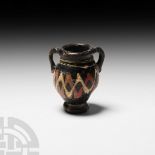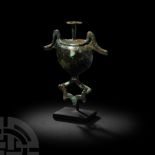Refine your search
Estimate
Category
- Jewellery (75)
- Sculpture (66)
- Arms, Armour & Militaria (51)
- Ceramics (39)
- Greek, Roman, Egyptian & Other Antiquities (37)
- Glassware (29)
- Collectables (21)
- Chinese Works of Art (19)
- Metalware (17)
- Taxidermy & Natural History (17)
- Salvage & Architectural Antiques (16)
- Ethnographica & Tribal Art (15)
- Books & Periodicals (14)
- Coins (12)
- Furniture (10)
- Russian Works of Art (9)
- Islamic Works of Art (8)
- Sporting Memorabilia & Equipment (7)
- Stamps (6)
- Vintage Fashion (6)
- Oil, Acrylic paintings & Mixed Media (5)
- Porcelain (5)
- Silver & Silver-plated items (5)
- Scientific Instruments (3)
- Musical Instruments & Memorabilia (2)
- Classic Cars, Motorcycles & Automobilia (1)
- Drawings & Pastels (1)
- Japanese Works of Art (1)
- Maps (1)
- Prints (1)
- Textiles (1)
- List
- Grid
A subscription to the Price Guide is required to view results for auctions ten days or older. Click here for more information
Ptolemaic Period, 332-31 B.C. A rectangular polychrome painted cartonnage panel, possibly a portion of mummy trapping, with slightly down-turned l...
Ptolemaic Period, 332-31 B.C. A rectangular wooden panel, possibly from a coffin, displaying a finely rendered painting of a cow with distinctive ...
Roman Period, c.30 B.C.-3rd century A.D. A substantial polychrome painted wooden coffin panel in two parts, from the chest down to the lower legs:...
Middle Kingdom, 2023-1862 B.C. A wooden model depicting a beer brewer in the process of making beer, composed of a figure with stylised anatomical...
Late Period-Roman Period, 664 B.C.-323 A.D. A wedge-shaped wooden support or furniture leg carved as the forelegs and head of a lion standing on a...
New Kingdom, 1550-1070 B.C. A finely modelled wooden figure of a high official carved in the round, standing facing, with a bald head, naturalisti...
Late Period-Ptolemaic Period, 664-30 B.C. A wood and copper-alloy figure of a sacred (African) ibis (threskiornis aethiopicus) modelled advancing ...
New Kingdom, 1569-1081 B.C. A fragment of a greywacke cosmetic spoon shaped as a fish with finely worked features and incised eye, scales, gill, a...
Late Period, 664-525 B.C. A red-brown glass or faience amulet in the form of a mongoose (herpestes ichneumon) crowned by a cobra, modelled resting...
Egyptian Glass Face Inlay
Late Period-Ptolemaic Period, 664-30 B.C. An opaque red glass anatomical inlay formed as the facing head and neck of a man. 1.85 grams, 18 mm (3/...
26th Dynasty, 664-525 B.C. A very large turquoise-glazed composition statuette depicting the goddess Isis seated on a throne, suckling her infant ...
Large Egyptian Statue of Bes
New Kingdom-early Third Intermediate Period, circa 1550-1069 B.C. A glazed steatite statue of the god Bes modelled in the round, his lion paws res...
18th Dynasty, 1335-1325 B.C. A carnelian scarab with naturalistic detailing to the carapace, head and legs; the underside bearing a cartouche cont...
New Kingdom-Late Period, 1550-332 B.C. A finely carved carnelian heart scarab (Scarabaeus sacer) modelled naturalistically in the round with anato...
Egyptian Feldspar Scarab
New Kingdom, 1550-1069 B.C. An amazonite feldspar scarab with simple detailing to the body and legs; drilled for suspension. 6.35 grams, 22 mm (7...
Middle Kingdom–Second Intermediate Period, 2133-1550 B.C. A translucent carnelian scarab with detailing to the head, body and legs; drilled for su...
Egyptian Amethyst Scarab
Late Middle Kingdom, 2055-1650 B.C. An amethyst scarab engraved with simple anatomical detailing to the head and legs; drilled for suspension. 4....
Middle Kingdom-Ptolemaic Period, 2133-31 B.C. A mixed group of Egyptian and other hardstone amulets of various types, including a haematite headre...
Late Period-Ptolemaic Period, 664-30 B.C. A group of six anatomical glass inlays comprising: a blue right hand and wrist clenched into a fist; a b...
New Kingdom, 1550-1069 B.C. and later. A restrung necklace composed of lapis lazuli papyrus flower amulets, lapis and other stone seed beads, gold...
Egyptian Statuette of Thoth
Late Period-Ptolemaic Period, 664-30 B.C. A copper-alloy statue depicting the ibis-headed god Thoth in a striding pose, left leg positioned in fro...
Late Period-Roman Period, 664 B.C.-323 A.D. A gilt copper-alloy panel of sub-rectangular form, displaying a repoussé figural scene composed of a P...
2nd-3rd century A.D. A group of four hollow-formed, bifacial sheet-gold beads comprising: a cockerel with repoussé detailing to the face, feathers...
Egyptian Gold Cat Amulet
Third Intermediate Period, 1069-702 B.C. A gold amuletic pendant in the form of a cat sitting on a tongue-shaped base, and associated with the god...
Egyptian Gold Horus Amulet
Late Dynastic Period, 1550–1069 B.C. A gold amulet depicting the god Horus represented here in falcon form surmounting the rectangular serekh, in ...
Egyptian Gold Baboon Amulet
New Kingdom-Roman Period, 1550 B.C.-323 A.D. A gold amulet formed in the round as a baboon, sacred to the god Thoth, walking on all-fours on a sle...
Late Period, 664-332 B.C. A glazed composition scarab with detailed serrated legs and cartouche of Tuthmoses III to the underside; set in a later ...
New Kingdom, Ramesside Period, 1550-1070 B.C. A rectangular limestone relief bearing the body of a high-ranking male dignitary facing right and th...
Old Kingdom, circa 2300 B.C. A sandstone relief section of sub-rectangular form, carved in raised relief with the bust of an offering bearer in pr...
Egyptian Figural Kohl Pot
Late Period, 664-525 B.C. A carved fine-grained limestone kohl pot in the form of a human head, depicted with semi-naturalistic facial features an...
New Kingdom, 1550-1069 B.C. The lower half of a stone statue of a seated figure, comprising an L-shaped base with decorative vertical striations a...
Ptolemaic Period, 332-30 B.C. A carved white marble figure of Horus in falcon-form, modelled in the round with stylised anatomical features; stand...
Egyptian Pink Stone Kohl Pot
Late Predynastic-Early Dynastic Period, 3100-2850 B.C. A pink marble or alabaster kohl pot of fusiform shape, two horizontal perforated handles to...
Phoenician Piriform Jug
8th century B.C. A piriform ceramic jug with trefoil mouth and integral ribbed handle; covered in a red slip with burnished surface; held in an an...
Late Period, 664-332 B.C. A black stone figure of Osiris wearing the White Crown of Upper Egypt, with remains of uninscribed tapering pillar to re...
New Kingdom, 19th-20th Dynasty, 1295-1077 B.C. A tall, elegant limestone shabti inscribed for Ir-nu; the figure with carefully modelled face with ...
New Kingdom, 19th Dynasty, 1292-1189 B.C. A blue-glazed composition shabti figurine for prince Khaemwaset wearing a bag wig with the sidelock of a...
Third Intermediate Period, 21st-22nd Dynasty, 1081-725 B.C. A typical deep blue glazed faience shabti of the period with black painted details and...
New Kingdom, mid 18th-early 19th Dynasty, early 14th-mid 13th century B.C. A frame containing fragments of ink inscribed papyri with remains of hi...
New Kingdom, mid 18th-early 19th Dynasty, early 14th-mid 13th century B.C. A frame containing fragments of ink inscribed papyri with remains of po...
New Kingdom, mid 18th-early 19th Dynasty, early 14th-mid 13th century B.C. A frame containing fragments of ink inscribed papyri with remains of po...
8th century B.C. An Athenian geometric high-rimmed bowl composed of a carinated body, shallow foot and twin 'ribbon' handles; painted friezes comp...
Circa 5th-4th century B.C. A substantial terracotta panther sculpture, the animal standing alert and with head turned upwards to left, its tail cu...
Circa 4th century B.C. A terracotta moulded figurine of the goddess Aphrodite standing with a himation draped from her forearms around her hips an...
8th-6th century B.C. A terracotta horse and rider figure modelled in the round standing on elongated stub legs, stout neck with stylised painted m...
Early 6th century B.C. A terracotta kohl vessel with narrow opening to the top, formed as a squatting comast, depicted naked with painted brown sp...
5th century B.C. A blackware skyphos of exceptional quality comprising a deep bowl and two loop handles set below the rim, waisted foot with carin...
5th-3rd century B.C. A black-glazed lidded pyxis with squat body, broad shoulder stamped with stylised floral vines, two round-section handles and...
1st century A.D. A Graeco-Roman turquoise blue faience jar probably made in Roman Egypt, in a form similar to that of a Greek column krater, with ...
Parthian Glazed Amphora
3rd-2nd century B.C. A glazed ceramic amphora bearing linear bands to the body and shoulders, broad tubular neck with everted rim, strap handles t...
Colossal Marble Head of Zeus
2nd century A.D. A colossal Roman white marble head section copied from an original Greek Hellenistic model, roughly comprising the left half of t...
Cypriot Limestone Head
Circa 6th century B.C. A fragmentary limestone female head modelled facing with semi-naturalistic facial features, her hair dressed in a coiffeur ...
Greek Minoan Breccia Bowl
Early 2nd millennium B.C. A Minoan breccia bowl of truncated conical form with broad inverted rim and rounded shoulder. Cf. The Metropolitan Museu...
Circa 5th-3rd century B.C. A green glass krater with two applied handles and splayed foot; areas of iridescence. 394 grams, 14.8 cm wide (5 3/4 i...
4th-1st century B.C. A capsule-shaped glass alabastron with a blue body and yellow marvered trails and zigzags, cylindrical neck and flange rim, w...
3rd-1st century B.C. An opaque glass alabastron composed of a fusiform body with slender neck and broad flange rim, applied ledge handles, decorat...
Greek Mosaic Glass Amphora
Circa 3rd century B.C. A miniature glass amphora with piriform body, carinated rim, applied handles and discoid foot, with polychrome geometric mo...
Early 5th century B.C. A bronze hydria composed of a tapering body, broad shoulder and waisted neck, the everted rim decorated with egg-and-dart m...
Geometric Period, 8th century B.C. A bronze sickle-type pyxis composed of a lentoid-section body with integral bird protomes, incised detailing an...
6th-4th century B.C. A bronze ladle with a deep hemispherical bowl and everted rim, long balustered handle with loop finial and bull’s head to the...



